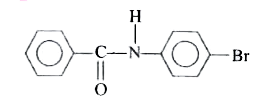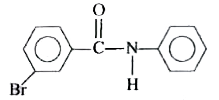In the given reaction [X] will be :
C6H5−C∣∣O−HNH2OH/H⊕−−−−−−−−→[X]
Mixture of syn and anti oxime
Only syn oxime
Only anti oxime
Reaction will not take place (NR)
The correct Answer is:A
To solve the question regarding the reaction of the given aldehyde with hydroxylamine (NH2OH) in the presence of an acid, we can follow these steps:
1. Identify the Reactants:
The given compound is a phenyl aldehyde, specifically benzaldehyde (C6H5CHO). The other reactant is hydroxylamine (NH2OH) in acidic medium.
2. Understand the Reaction:
The reaction between an aldehyde and hydroxylamine leads to the formation of an oxime. In this case, the aldehyde (C6H5CHO) will react with NH2OH.
3. Write the Reaction:
The reaction can be represented as:
C6H5CHO+NH2OHH+−−→C6H5C=N−OH+H2O
Here, water (H2O) is eliminated in a condensation reaction.
4. Identify the Product:
The product formed is an oxime, which can be represented as C6H5C=N-OH. The nitrogen atom can have a lone pair of electrons, and the hydroxyl group (OH) is attached to it.
5. Consider the Isomerism:
The oxime can exist in two geometric forms: syn and anti. The syn form has the hydroxyl group and the phenyl group on the same side of the double bond, while the anti form has them on opposite sides.
6. Conclusion:
The final product (X) will be a mixture of both syn and anti isomers of the oxime.
Final Answer:
The product (X) is a mixture of syn and anti isomers of the oxime.
The given compound is a phenyl aldehyde, specifically benzaldehyde (C6H5CHO). The other reactant is hydroxylamine (NH2OH) in acidic medium.
The reaction between an aldehyde and hydroxylamine leads to the formation of an oxime. In this case, the aldehyde (C6H5CHO) will react with NH2OH.
The reaction can be represented as:
C6H5CHO+NH2OHH+−−→C6H5C=N−OH+H2O
Here, water (H2O) is eliminated in a condensation reaction.
The product formed is an oxime, which can be represented as C6H5C=N-OH. The nitrogen atom can have a lone pair of electrons, and the hydroxyl group (OH) is attached to it.
The oxime can exist in two geometric forms: syn and anti. The syn form has the hydroxyl group and the phenyl group on the same side of the double bond, while the anti form has them on opposite sides.
The final product (X) will be a mixture of both syn and anti isomers of the oxime.
The product (X) is a mixture of syn and anti isomers of the oxime.
Similar Questions
Knowledge Check
In the given reaction [X] will be:
C6H5−C∣∣O−HNH2OH/H⊕−−−−−−−−→[X]Aonly syn oximeBonly anti aximeCmixture of syn and anti oximeDsecondary amideIn the reaction sequence
C6H5−C∣∣O−CH3NH2OH/H⊕−−−−−−−−→[X]PCl5−−→[Y], will beAC6H5−O∣∣C−NHCH3BCH3−O∣∣C−NH−C6H5CC6H−CH2−O∣∣C−NH2DMixture of a and bThe final product (C) of the following reaction would be:
C6H5−C∣∣O−C6H5H2N−OH−−−−−−→APCl5−−→BBr2/Fe−−−−→C+A B
B C
C D
D
Write the structure of the product A & B
C2H5−C∣∣O−O18C2H5H3O⊕−−−→A+B
View SolutionThe major product of the following reaction is :
C6H5CH2−CH3∣C∣Br=CH2−CH3C2H5ONa−−−−−→C2H5OH
View SolutionThe major product of the following reaction is :
C6H5CH2−CH3∣C∣Br−CH2−CH3C2H5ONa−−−−−→C2H5OH
View SolutionIn the given reaction the products is :
CH3−CH2−C∣∣O−OCH3+CH3−C∣∣O−OCH3(1)CH3OΘNa+−−−−−−−−−−→(2)CH3OHoversert(H2O)−−→Δ product
View SolutionIn the given reaction:
Ph−C∣∣O−CH3H2N−OH−−−−−−−−→H⊕(X)PCl5−−−−−→Δ(Y) Y will be
View Solution
